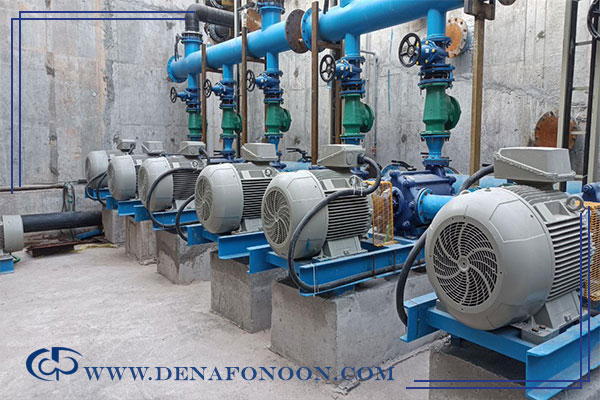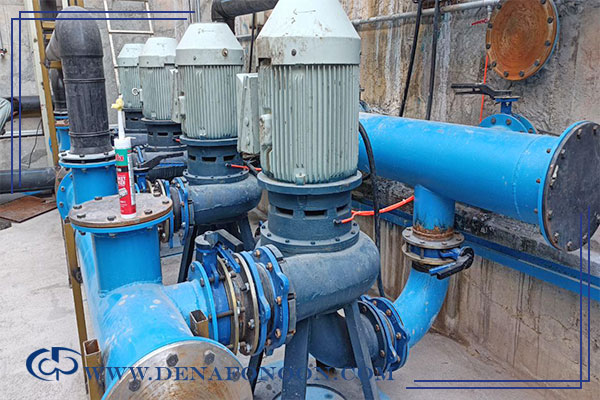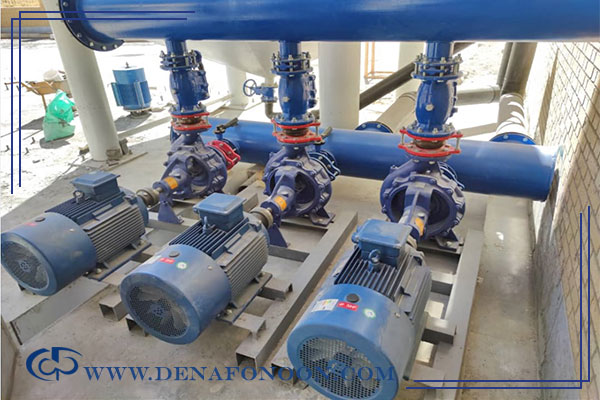Types of booster pumps | What is a booster pump
Types of booster pumps ,What is a booster pump
VisitCount 22
Booster Pump
With the increasing population in urban and rural areas, as well as the impact of various factors that lead to reduced water pressure—such as:
- Leakage and damage in water supply pipelines
- Deficiencies caused by fittings along the flow path
- Increased water demand during peak consumption hours, and more
the need for a reliable pressure boosting system has become essential. The same necessity is strongly felt in many industries and factories where maintaining proper and consistent water pressure is critical. Denafonoon Company is one of the manufacturers of booster pumps that provides solutions to meet these demands.
What is a Booster Pump:

A booster pump is a device in which multiple water pumps are connected in parallel to increase overall water flow and maintain sufficient pressure. In general, booster pumps used in water supply, firefighting, and irrigation systems are designed to enhance fluid pressure. They are also widely applied in municipal water distribution, treatment plants, and transferring water to higher elevations.
Main Components of a Booster Pump
A booster pump typically consists of:
- Pipes and fittings
- Pumps
- Valves and accessories
- Electrical equipment
- Control systems (such as motors and control panels)
How Does a Booster Pump Work?
The booster pump keeps the distribution network under a constant and adjustable pressure. When water consumption begins, the first pump is activated to supply the demand. If usage increases, additional pumps automatically switch on, one by one, to maintain stable pressure.
This process prevents overloading individual pumps, reduces energy loss, and extends the lifespan of the system.
At Denafonoon Company, inverter technology is integrated into booster pump systems to optimize energy efficiency, minimize power consumption, and lower operating costs for customers.
Centrifugal Booster Pump
Centrifugal booster pumps are designed to transfer energy continuously to the fluid. They usually operate with an electric motor, where power is transmitted from the motor shaft to the pump shaft through a coupling.
The pump features a spiral-shaped casing (volute) that houses one or more impellers mounted on a shaft. These impellers, equipped with multiple blades, transfer mechanical energy to the liquid, ensuring efficient pressure boosting and smooth flow.
Applications of Booster Pumps
Booster pumps are used in various locations depending on their purpose, such as sports facilities, factories, residential complexes, firefighting systems, recreational halls, and more.
It is worth mentioning that Denafonoon Company specifically designs and manufactures booster pumps for use in stone-cutting factories.
In some cases, pumps are required to lift water to higher elevations, which may require a two-stage pumping process. A water supply booster pump circulates water throughout the pipeline, maintains constant pressure, and eliminates the need for oversized single pumps.
Important note: If a booster pump operates in a “dry run” condition (without water), it will be damaged. For this reason, pumps are always connected to a storage tank, ensuring steady water supply and protection of the system. The tank size must be determined by a professional engineer.
Types of Booster Pumps

- Domestic booster pumps
- Water supply booster pumps
- Firefighting booster pumps
Booster Pump Adjustment
To properly utilize all the capabilities of a booster pump, it is essential to perform its settings correctly. The booster pump settings include the following steps:
1. Pressure Sensor Adjustment:
In this step, the pressure sensor (pressure transmitter) must be calibrated accurately to display the desired pressure correctly.
2.Booster Pump Controller Adjustment:
- The controller parameters should be set according to the drive used for the pumps, allowing the controller to manage the drive effectively.
- The controller should also be configured to identify faulty pumps and replace them with operational ones.
- In addition, the controller monitors the water level in the storage tank and reports it accordingly.
3.Preventing Dry Run:
The booster pump must be set so that, in case of inlet water supply interruption and dry running, it can automatically detect the issue and trigger the corresponding alarm.
Furthermore, the operating time of the pumps should be configured to ensure uniform operation. Uniform operation refers to time-based distribution, meaning that all pumps (whether 2, 3, or more) should enter the circuit equally, so the workload is shared, minimizing wear and failures.
4. Sleep Frequency Adjustment:
This ensures that the booster pump can determine when to enter standby mode. For example, when all water outlet valves are closed, the booster pump should detect this and switch to standby. To achieve this functionality, the settings must be done properly.
5.Internal Self-Service Adjustment:
In this mode, pumps are periodically started, and the one that has been inactive for a long time should be activated to prevent seizing. Prolonged inactivity may cause the pump to seize.
6. PID Parameter Adjustment:
If not configured correctly, the booster pump will fail to maintain the required pressure properly. However, the booster pump must keep the desired pressure constant.
7. Delay Time Adjustment Between Pump Switching:
This setting applies when the frequency of the first pump reaches its nominal value and waits for the next pump to enter the system. The required time delay is configured in this section.
Booster Pump vs. Standard Water Pump
As urban populations and large residential complexes continue to grow, supplying sufficient water—especially to upper floors—has become increasingly difficult. To solve this, domestic water pumps are commonly used, which themselves come in several types.
However, traditional fixed pumping systems often face problems. In these systems, a constant volume of water is pumped into the pipes, and sudden pressure surges caused by pumps starting simultaneously can lead to:
- Damage to water pipes
- Damage to valves and fittings
- Temporary water shortages in certain areas due to pressure drops when pumps shut down together
Booster pumps eliminate these issues by stabilizing and regulating water pressure and flow according to variable demand, ensuring maximum efficiency and system safety.
Disadvantages of Not Using a Booster Pump
1. No control over water consumption
2. Excessive water usage in production lines
3. Increased electricity consumption
4. Continuous operation of pumps, leading to high wear and tear on pumps and pipelines
5. Continuous water flow over production equipment, causing corrosion and rust
6. Inability to install valves in the line
7. Excessive consumption of clean water and coagulants
8. Unnecessary increase in operating costs
Advantages of Using a Booster Pump
1. Ability to install valves in the pipeline
2. Control over water consumption in the system
3. Control of water flow (discharge rate) delivered by pumps through integrated valves
4. Intelligent management of pumps via booster pump control systems
5. Reduced operating hours of pumps, leading to lower electricity consumption and extended lifespan of equipment
Booster Pump Manufacturers
Some well-known booster pump manufacturers include:
- Novin Pump producer of various industrial booster pumps in Iran
- Pump Online one of the leading companies in the booster pump industry
- Kooshesh & Development Engineering Company
- Arsh Sanat Kooshesh Trading & Manufacturing
- Gozineh Sanat Tasissat
- DAB Booster Pump
- Pompiran Booster Pump








